Canon EF 16-35 mm f/4L IS USM
3. Build quality and image stabilization
In the photo below the tested lens is positioned between the Canon EF 50 mm f/1.4 USM and the EF-S 10–18 mm f/4.5–5.6 IS STM designed for smaller sensors.
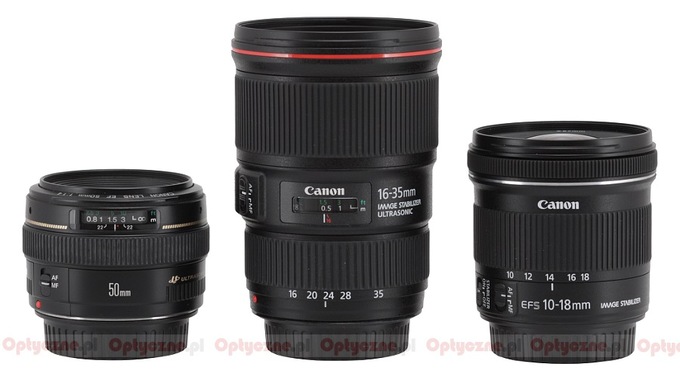 |
Please Support UsIf you enjoy our reviews and articles, and you want us to continue our work please, support our website by donating through PayPal. The funds are going to be used for paying our editorial team, renting servers, and equipping our testing studio; only that way we will be able to continue providing you interesting content for free. |
- - - - - - - - - - - - - - - - - - - - - - - - - - - - - - - - - - - - - - - - - - - - - - - -
The Canon EF 16–35 mm f/4L IS USM starts with a metal mount surrounding a plate with contacts and a rear element, 28 mm in diameter. That element is situated on the same level as the mount at 16 mm focal length. When you pass to the 35 mm focal length it hides about 2.5 cm deep. Then you can take a good look at the interior of the tube which is well matted and blackened, without any traces of shiny screws or electronic parts.
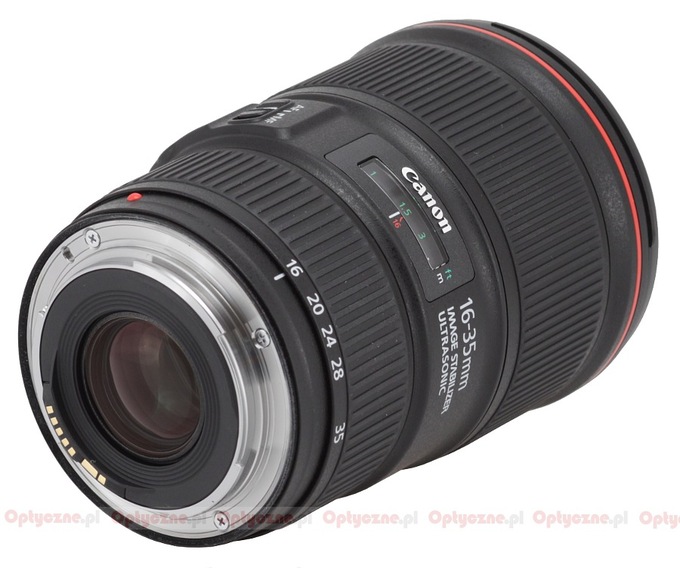 |
The proper body of the lens starts with a narrow, immobile stripe featuring a red dot which makes the alignment with a camera easier. The next part is a zoom ring, 25 mm wide, with rubber ribs and focal length markings at 16, 20,24, 28 and 35 mm. The ring moves evenly and is well-damped.
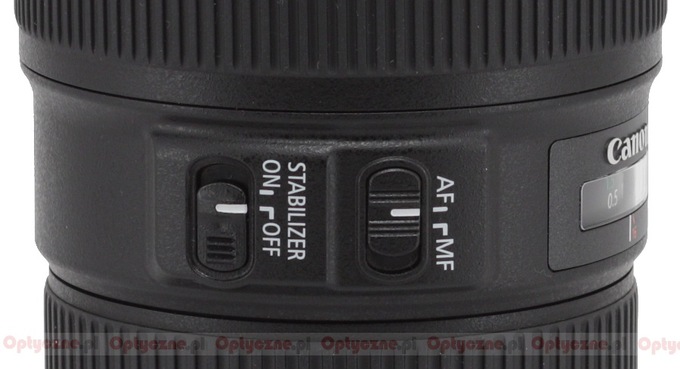 |
Further on you find a distance scale, expressed in meters and feet, behind a window. On its right side there is an inscription stating the parameters of the lens and on the left a focusing mechanism mode switch (AF/MF) and a stabilization switch (STABILIZER ON/OFF). On the opposite side of the distance scale you see the serial number of the lens and the info that it was produced in Japan.
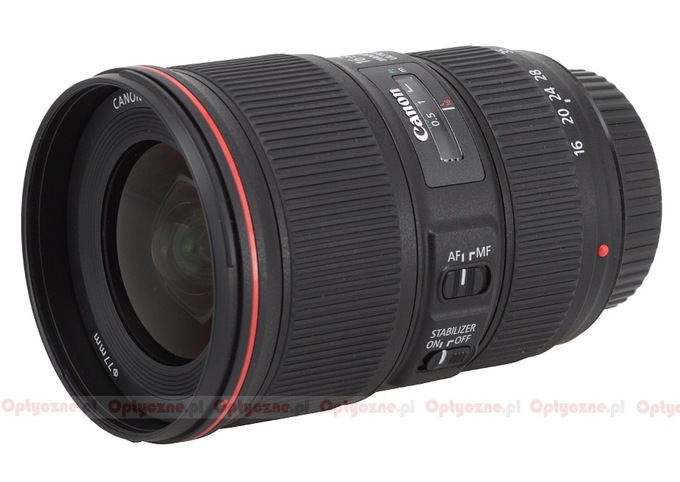 |
The next part is a manual focus ring – 35 mm wide, ribbed and very comfortable to use. It moves smoothly, is well-damped and doesn’t have any slacks. Running through the whole distance scale needs a turn through 100-110 degrees. It is an acceptable value, taking into account the parameters and the depth of field of the tested lens.
Behind the ring you find a red stripe, characteristic for the L series, which turns into a hood mount.
The front element is less than 50 mm in diameter, surrounded by a non-rotating filter thread, 77 mm in diameter. The element is the closest to the thread at 16 mm and it hides the deepest inside near 24 mm. The lens is fully sealed only when you screw the filter on.
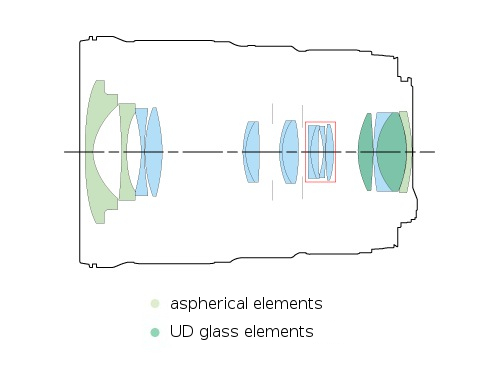 |
When it comes to the optical construction you deal here with 16 elements positioned in 12 groups. Three elements are aspherical and two are made of low dispersion UD glass. Inside there is also a circular aperture with nine diaphragm blades which can be closed to f/22.
Buyers get both caps, a petal-type hood and a soft pouch in the box.
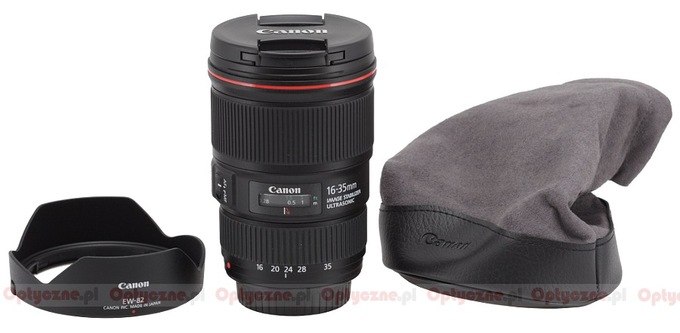 |
It is also worth mentioning that, beginning with the launch of the EF-S 10–18 mm and the EF 16–35 mm f/4L IS USM lenses, the Canon company changed the packaging from white into gray-silver.
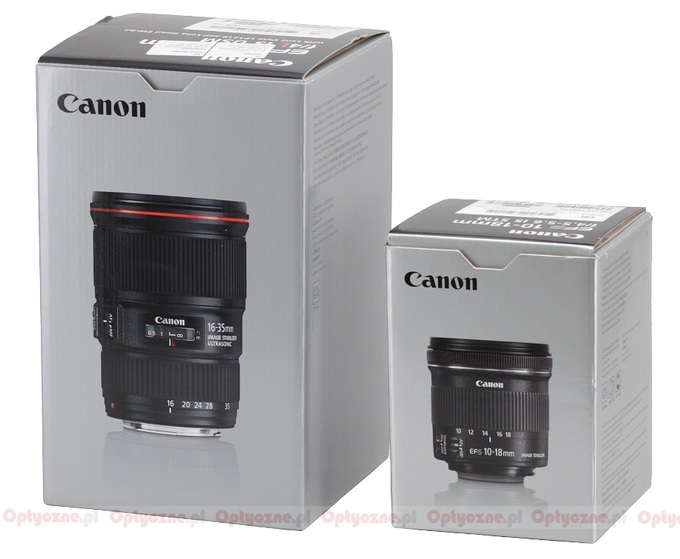 |
Optical stabilization
The Canon company claims that the image stabilization system in their lenses is as efficient as 4 EV. When it comes to their more expensive devices it is often true but the stabilization of the cheaper ones is sometimes worse than that. How does it look in the case of the EF 16-35 mm f/4L model? At 35 mm focal length we took several dozen photos at every exposure time ranging from 1/40 to 0.8 of a second, with the stabilization switched on and off. The percentage of blurred photos we presented on the graph below (the 0 EV point being the equivalent of 1/30 of a second).
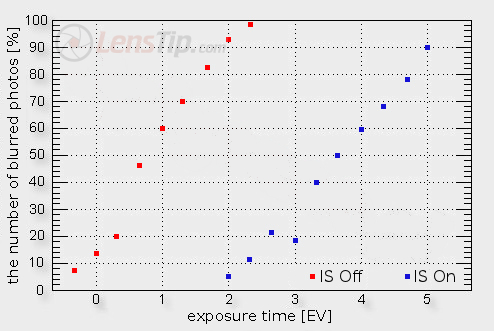
The maximum distance between both curves amounts to 3.3 EV and such is the efficiency of the stabilization of the tested lens. It is a good result but still short of these declared 4 EV.






